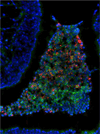The pneumococcus: why a commensal misbehaves
- PMID: 19898768
- PMCID: PMC4487619
- DOI: 10.1007/s00109-009-0557-x
The pneumococcus: why a commensal misbehaves
Abstract
Several characteristics of Streptococcus pneumoniae (pneumococcus) combine to make it a particularly problematic pathogen. Firstly, the pneumococcus has the capacity to cause disease through the expression of virulence factors such as its polysaccharide capsule and pore-forming toxin. In addition, the pneumococcus is highly adaptable as demonstrated by its ability to acquire and disseminate resistance to multiple antibiotics. Although the pneumococcus is a major cause of disease, the organism is most commonly an "asymptomatic" colonizer of its human host (the carrier state), with transmission occurring exclusively from this reservoir of commensal organisms. Thus, it is unclear how the organism's virulence and adaptability promote its persistence or host to host spread during its carrier state. This review summarizes current understanding of how these characteristics may contribute to the commensal lifestyle of the pneumococcus.
Conflict of interest statement
Figures

References
-
- Tomasz Pneumococcus at the gates. New Eng J Med. 1995;333:514–515. - PubMed
-
- Musher D. How contagious are common respiratory tract infections? N Engl J Med. 2003;348:1256–1266. - PubMed
-
- Austrian R. Some aspects of the pneumococcal carrier state. J Antimicrob Chemother. 1986;18:35–45. - PubMed
-
- Bogaert D, de Groot R, Hermans P. Streptococcus pneumoniae colonisation: the key to pneumococcal disease. Lancet Infect Dis. 2004;4:144–154. - PubMed
Publication types
MeSH terms
Substances
Grants and funding
LinkOut - more resources
Full Text Sources
Medical

